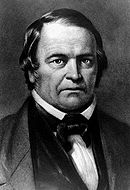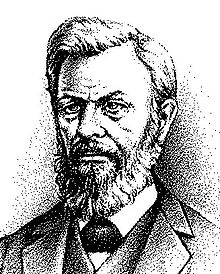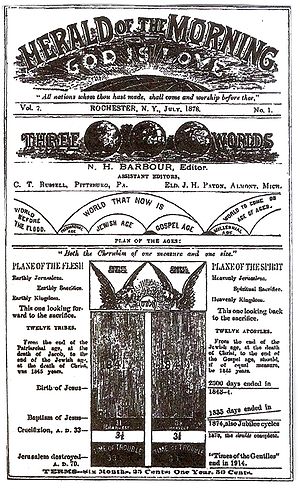- Nelson H. Barbour
-
Part of a series on Adventism 
Background and history Christianity · Protestantism
Anabaptists · Restorationism
Pietism · Millerites
Great DisappointmentBiographies William Miller
Nelson H. Barbour · Joseph Bates
Sylvester Bliss · Jonathan Cummings
Elon Galusha · Apollos Hale
Joshua V. Himes · Charles F. Hudson
Josiah Litch · Rachel O. Preston
T. M. Preble · George Storrs
John T. Walsh · Jonas Wendell
Ellen G. White · James White
John ThomasTheology Annihilationism
Conditional immortality
Historicism · Intermediate state
PremillennialismDenominations Advent Christian Church
Christadelphians
Seventh-day Adventist Church
Church of God (Seventh-Day)
Church of God General Conference
Church of the Blessed Hope
Seventh Day Adventist Reform Mov't
Davidian SDA (Shepherd's Rod)
United Seventh-Day Brethren
Branch Davidian
Primitive Advent Christian ChurchNelson Horatio Barbour was born in Throopsville, New York, August 21, 1824, and died in Tacoma, Washington, August 30, 1905. Barbour was an influential Adventist writer and publisher, best known for his association with and later opposition to Charles Taze Russell.
Contents
Life
Barbour was the son of David Barbour and the grandson of Friend Barbour. Both the family and official documents use the spelling "Barbour" and its alternative spelling "Barber."
He was related to a number of prominent New Yorkers including Dio Lewis. He attended Temple Hill Academy at Geneseo, New York, from 1839-1842. While at Temple Hill he also studied for the Methodist Episcopal ministry with an Elder Ferris, probably William H. Ferris.
Barbour was introduced to Millerism through the efforts of a Mr. Johnson who lectured at Geneseo, in the winter of 1842. Barbour associated with other Millerites living in that area. These included Owen Crozier, William Marsh, and Daniel Cogswell. Cogswell would become a life-long friend as would Henry F. Hill. Cogswell would go on to become president of the New York Conference of the Advent Christian Church. Hill would become a prominent author associated with the Evangelical Adventists.
Adventists in the Geneseo area met in Springwater to await the second coming in 1843. Their disappointment was profound, and Barbour suffered a crisis of faith. Later, he would write: “We held together until the autumn of 1844. Then, as if a raft floating in deep water should suddenly disappear from under its living burden, so our platform went from under us, and we made for shore in every direction; but our unity was gone, and, like drowning men, we caught at straws.”[1]
Barbour abandoned his faith. He pursued a medical career, becoming a medical electrician, a therapist who treated disease through the application of electric current, which was seen as a valid therapy in those days.
He left for Australia to prospect for Gold, returning via London in 1859. There is some evidence that he preached on occasion while in Australia. A ship-board discussion with a clergyman reactivated his interest in Bible prophecy. He consulted books on prophetic themes at the British Library and became convinced that 1873 would mark the return of Christ. This was not a new speculation but had been advanced by others at least as early as 1823.
Returning to the United States, Barbour settled in New York City, continuing his studies in the Astor Library. When fully convinced he wrote letters and visited those whom he felt might best spread the message. Few were interested.
Barbour became an inventor and associated with Peter Cooper, the founder of Cooper Union. He patented several inventions. By 1863 he was in medical practice, dividing his time between Auburn and Rochester, New York. He returned to London in 1864 to demonstrate one of his inventions. He used his association with other inventors and scientists to spread his end-times doctrine, and some of his earliest associates in that belief were inventors and physicians.
He published something as early as 1867, though it has been lost. In 1871 he wrote and published a small book entitled Evidences for the Coming of the Lord in 1873, or The Midnight Cry. It quickly went through two printings and articles by him started appearing in the Second Adventist press, notably the World’s Crisis.
A significant movement advocating 1873 grew up, though it was divided into several parties. Jonas Wendell lead one; another centered on the magazine The Watchman’s Cry, and the rest associated most closely with Barbour. British Barbourites were represented by Elias H. Tuckett, a clergyman.
Many gathered at Terry Island to await the return of Christ in late 1873. Christ failed to return and the group dissolved. Barbour and others looked to the next year. That proved a disappointment too.
Led by Benjamin W. Keith, an associate of Barbour’s since 1867, the group took up the common belief in a two-stage, initially invisible presence. They believed that Christ had indeed come in 1874 and would soon become visible for judgments. Barbour started a magazine in December 1873 to promote his views, calling it The Midnight Cry. He quickly changed the name to Herald of the Morning. After announcing the invisible presence doctrine, the group dwindled into insignificance.
In December 1875 Charles Taze Russell, then a businessman from Allegheny, received a copy of The Herald of the Morning. He met the principals in the Barbourite movement and arranged for Barbour to speak in Philadelphia in 1876. Barbour and Russell began their association, during which Barbour wrote the book The Three Worlds (1877) and published a small booklet by Russell entitled Object and Manner of Our Lord’s Return. Beginning in 1878, they each wrote of conflicting views on Ransom and Atonement doctrine. By May 3, 1879, Russell wrote that their "points of variance seem to me to be so fundamental and important that...I feel that our relationship should cease." In a May 22, 1879 letter to Barbour, Russell explicitly resigned: “Now I leave the ‘Herald’ with you. I withdraw entirely from it, asking nothing from you . . . Please announce in next No. of the ‘Herald’ the dissolution and withdraw my name [as assistant editor on the masthead].” Beginning in July 1879, Russell began publishing the magazine now known as The Watchtower,[2] the principal journal for the initial Bible Student movement and eventually for Jehovah's Witnesses.
By 1883 Barbour abandoned belief in an invisible presence and returned to more standard Adventist doctrine. He had organized a small congregation in Rochester in 1873, and by 1878 he was in better quarters. He changed the name of the congregation to Church of the Strangers. In later years the congregation would associate with the Church of the Blessed Hope and call themselves Restitutionists. The only known photo of Nelson Barbour appeared in the Rochester Union and Advertiser in October 1895.
Barbour continued the Herald of the Morning, though with breaks, until at least 1903, occasionally issuing statements critical of C. T. Russell. He wrote favorably though cautiously that he was persuaded 1896 was the date for Christ's visible return. This wasn't original with him, but grew out of the Advent Christian Church. The last date set by Barbour for Christ’s return was 1907.
By the time of his death the Rochester church numbered about fifty and there was very minor interest elsewhere. In 1903 Barbour participated in a conference on Mob Spirit in America. He advocated the establishment of a predominately black state in the American south west.
Barbour died while on a trip to the west in 1905 of “exhaustion.”
After his death some of his articles from The Herald of the Morning were collected and published in book form as Washed in His Blood (1908).
Bibliography
- B. W. Schulz and Rachael de Vienne: Nelson Barbour: The Millennium's Forgotten Prophet, 2009. Published by Fluttering Wings Press, via lulu.com
- B. W. Schulz and Rachael de Vienne: Nelson Barbour: The Time-ists Last Breath, Journal From the Radical Reformation, Spring 2008, page 54ff. Available as pdf at the COGGC web site.
Biography
The Rochester Union and Advertiser for October 5, 1895, page 12 offers the following information on Nelson Barbour:
- "Nelson H. Barbour was born at Toupsville, three miles from Auburn, N. Y., in 1824. At an early age the family moved to Cohocton, Stueben County, N. Y. From the age of 15 to 18, he attended school at Temple Hill Academy, Genseco, New York; at which place he united with the Methodist Episcopal Church, and began a preparation for the ministry under elder Ferris. Having been brought up among Presbyterians, however, and having an investigating turn of mind, instead of quietly learning Methodist theology he troubled his teacher with questions of election, universal salvation, and many other subjects, until it was politely hinted that he was more likely to succeed in life as a farmer than as a clergyman. But his convictions were strong that he must preach the gospel even if he could not work in any theological harness. And at 19, he began his life work as an independent preacher. Since which, all that is worth reporting in his life is inseparable from his theological growth. He could not believe in an all wise and loving Father, permitting the fall; then leaving man's eternal destiny to a hap-hazard scramble between a luke-warm Church and a zealous devil. On the contrary he believed the fall was permitted for a wise purpose; and that God has a definite plan for man, in which nothing is left to chance or ignorance.
- "Mr. Barbour believes that what he denominated the present babel of confusion in the churches is the result of false teaching and the literal interpretation of the parables.
- "The Church of the Strangers was organized in 1879. Mr. Barbour has preached in England, in several Australian colonies, in Canada, and many states of the Union. For the past twenty-two years he has published the Herald of the Morning in this city; claiming that in his 'call' to preach, he confered [sic] not with flesh and blood. Nor was he called to convert the world; but independent of creed, to search for the truth 'as it is in Jesus,' the 'second man Adam,' believing that the restored faith is a precurser [sic] of the millenium [sic] and 'Times of restitution of all things.'"
See also
References
External links
- The Three Worlds, written by Barbour, and financed by Russell in 1877.
- Evidences for the Coming of the Lord in 1873, or The Midnight Cry Written by Barbour in 1871.
- Message to Herald of the Morning subscribers 1879 Pittsburgh, Pa; Zion's Watch Tower and Herald of Christ's Presence, July 1, 1879, Supplement
- Barbour Biography Project
- Washed in the Blood Published anonymously but listed in the library of Congress card catalog as written by Nelson H. Barbour.
- Herald of the Morning Assorted Issues from 1875 to 1880.
Categories:- American Christian ministers
- Adventism
- 1824 births
- 1905 deaths
Wikimedia Foundation. 2010.


